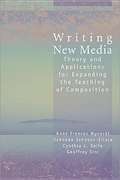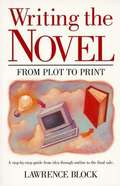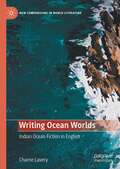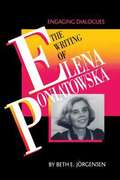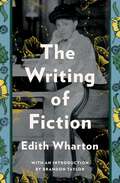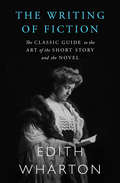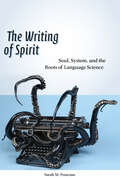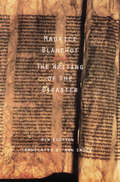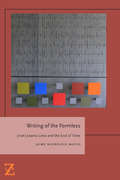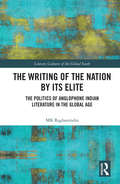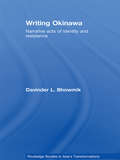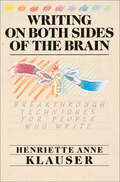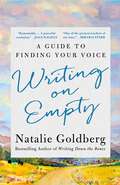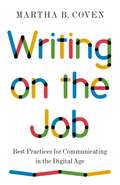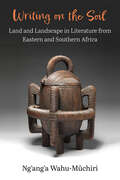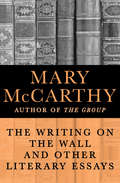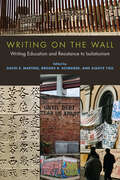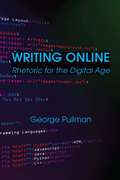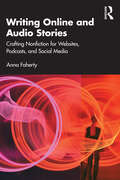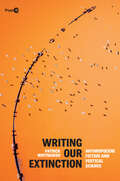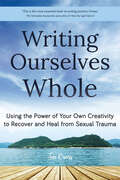- Table View
- List View
Writing New Media
by Anne WysockiAs new media mature, the changes they bring to writing in college are many and suggest implications not only for the tools of writing, but also for the contexts, personae, and conventions of writing. An especially visible change has been the increase of visual elements-from typographic flexibility to the easy use and manipulation of color and images. Another would be in the scenes of writing-web sites, presentation "slides," email, online conferencing and coursework, even help files, all reflect non-traditional venues that new media have brought to writing. By one logic, we must reconsider traditional views even of what counts as writing; a database, for example, could be a new form of written work. The authors of Writing New Media bring these ideas and the changes they imply for writing instruction to the audience of rhetoric/composition scholars. Their aim is to expand the college writing teacher's understanding of new media and to help teachers prepare students to write effectively with new media beyond the classroom. Each chapter in the volume includes a lengthy discussion of rhetorical and technological background, and then follows with classroom-tested assignments from the authors' own teaching.
Writing The Novel: From Plot To Print
by Lawrence BlockBlock covers every step of the novel writing and selling process to help writers deliver a salable manuscript to the right editor's desk.
Writing Occupation: Jewish Émigré Voices in Wartime France (Stanford Studies in Jewish History and Culture)
by Julia ElskyAmong the Jewish writers who emigrated from Eastern Europe to France in the 1910s and 1920s, a number chose to switch from writing in their languages of origin to writing primarily in French, a language that represented both a literary center and the promises of French universalism. But under the Nazi occupation of France from 1940 to 1944, these Jewish émigré writers—among them Irène Némirovsky, Benjamin Fondane, Romain Gary, Jean Malaquais, and Elsa Triolet—continued to write in their adopted language, even as the Vichy regime and Nazi occupiers denied their French identity through xenophobic and antisemitic laws. In this book, Julia Elsky argues that these writers reexamined both their Jewishness and their place as authors in France through the language in which they wrote. The group of authors Elsky considers depicted key moments in the war from their perspective as Jewish émigrés, including the June 1940 civilian flight from Paris, life in the occupied and southern zones, the roundups and internment camps, and the Resistance in France and in London. Writing in French, they expressed multiple cultural, religious, and linguistic identities, challenging the boundaries between center and periphery, between French and foreign, even when their sense of belonging was being violently denied.
Writing Ocean Worlds: Indian Ocean Fiction in English (New Comparisons in World Literature)
by Charne LaveryThis book explores the Indian Ocean world as it is produced by colonial and postcolonial fiction in English. It analyses the work of three contemporary authors who write the Indian Ocean as a region and world—Amitav Ghosh, Abdulrazak Gurnah, and Lindsey Collen—alongside maritime-imperial precursor Joseph Conrad. If postcolonial literatures are sometimes read as national allegories, this book presents an account of a different and significant strand of postcolonial fiction whose geography, in contrast, is coastal and transoceanic. This work imaginatively links east Africa, south Asia and the Arab world via a network of south-south connections that precedes and survives European imperialism. The novels and stories provide a vivid, storied sense of place on both a local and an oceanic scale, and in so doing remap the world as having its centre in the ocean and the south.
The Writing of Elena Poniatowska: Engaging Dialogues
by Beth E. JörgensenElena Poniatowska is one of Latin America's most distinguished and innovative living writers. Advocacy of women and the poor in their struggle for social and economic justice, denunciation of the repression of that struggle, and a tendency to blur the boundaries between conventional literary forms characterize her writing practice.
The Writing of Fiction: The Classic Guide To The Art Of The Short Story And The Novel (The\collected Works Of Edith Wharton)
by Edith WhartonA rare work of nonfiction from Edith Wharton, The Writing of Fiction contains brilliant advice on writing from the first woman ever to win a Pulitzer Prize -- for her first novel The Age of Innocence. In The Writing of Fiction, Wharton provides general comments on the roots of modern fiction, the various approaches to writing a piece of fiction, and the development of form and style. She also devotes entire chapters to the telling of a short story, the construction of a novel, and the importance of character and situation in the novel. Not only a valuable treatise on the art of writing, The Writing of Fiction also allows readers to experience the inimitable but seldom heard voice of one of America's most important and beloved writers, and includes a final chapter on the pros and cons of Marcel Proust.
The Writing of Fiction: The Classic Guide to the Art of the Short Story and the Novel (The\collected Works Of Edith Wharton)
by Edith WhartonEssays on the craft of fiction writing from the first woman to win the Pulitzer Prize, for her novel The Age of Innocence.In The Writing of Fiction,Edith Wharton, a prolific writer and one of the twentieth century&’s greatest authors, shares her thoughts on fiction writing, devoting individual chapters to short stories and novels. She stresses the importance of writers putting thought into how they build their story, from selecting subject matter and fashioning characters to crafting situations and settings. She explores the history of modern fiction and the contributions of Honoré de Balzac and Stendhal. She even examines the difference between literary and commercial fiction, as well as the work of Marcel Proust.Although Wharton passed away in 1937, her advice here endures and is bound to inspire writers for ages to come. &“In The Writing of Fiction Edith Wharton gives us not only a period-appropriate glimpse into the mind of an exceptionally creative writer but also an appreciation for the thoughtfulness and discipline she brought to her craft. We are fortunate she was willing to share her observations.&” —Ralph White, author of Litchfield
The Writing of Modern Fiction
by Robert SomerlottThe author, a novelist and short-story writer with extensive experience teaching creative writing, gathers suggestions for beginning fiction writers. He discusses character, plot, suspense, the use of detail, and more. Many examples are drawn from the author's own work and experience, and from the works of other writers including Flannery O'Connor, John Steinbeck, and William Maxwell.
The Writing of Spirit: Soul, System, and the Roots of Language Science
by Sarah M. PourciauContemporary thought has been profoundly shaped by the early-twentieth-century turn toward synchronic models of explanation, which analyze phenomena as they appear at a single moment, rather than diachronically as they develop through time. But the relationship between time and system remains unexplained by the standard account of this shift. Through a new history of systematic thinking across the humanities and sciences, The Writing of Spirit argues that nineteenth-century historicism wasn’t simply replaced by a more modern synchronic perspective. The structuralist revolution consisted rather in a turn toward time’s absolutely minimal conditions, and thus also toward a new theory of diachrony.Pourciau arrives at this surprising and powerful conclusion through an analysis of language-scientific theories over the course of two centuries, associated with thinkers from Jacob Grimm and Richard Wagner to the Russian Futurists, in domains as disparate as historical linguistics, phonology, acoustics, opera theory, philosophy, poetics, and psychology. The result is a novel contribution to a pressing contemporary question—namely, what role history should play in the interpretation of the present.
The Writing of the Disaster
by Maurice Blanchot Ann SmockModern history is haunted by the disasters of the century—world wars, concentration camps, Hiroshima, and the Holocaust—grief, anger, terror, and loss beyond words, but still close, still impending. How can we write or think about disaster when by its very nature it defies speech and compels silence, burns books and shatters meaning? The Writing of the Disaster reflects upon efforts to abide in disaster’s infinite threat. First published in French in 1980, it takes up the most serious tasks of writing: to describe, explain, and redeem when possible, and to admit what is not possible. Neither offers consolation. Maurice Blanchot has been praised on both sides of the Atlantic for his fiction and criticism. The philosopher Emmanuel Levinas once remarked that Blanchot's writing is a "language of pure transcendence, without correlative." Literary theorist and critic Geoffrey Hartman remarked that Blanchot's influence on contemporary writers "cannot be overestimated."
Writing of the Formless: Jose Lezama Lima and the End of Time (Lit Z)
by Jaime Rodríguez MatosIn this book, Jaime Rodríguez Matos proposes the “formless” as a point of departure in thinking through the relationship between politics and time. Thinking through both literary and political writings around the Cuban Revolution, Rodríguez Matos explores the link between abstract symbolic procedures and various political experiments that have sought to give form to a principle of sovereignty based on the category of representation. In doing so, he proposes the formless as the limit of modern and contemporary reflections on the meaning of politics while exploring the philosophical consequences of a formless concept of temporality for the critique of metaphysics.Rodríguez Matos takes the writing and thought of José Lezama Lima as the guiding thread in exploring the possibility of a politicity in which time is imagined beyond the disciplining functions it has had throughout the metaphysical tradition—a time of the absence of time, in which the absence of time no longer means eternity.
The Writing of the Nation by Its Elite: The Politics of Anglophone Indian Literature in the Global Age (Literary Cultures of the Global South)
by MK RaghavendraThis volume examines the idea of India as it emerges in the writing of its anglophone elite, post-2000. Drawing on a variety of genres, including fiction, histories, non-fiction assessments – economic, political, and business – travel accounts, and so on, this book maps the explosion of English-language writing in India after the economic liberalization and points to the nation’s sense of its growing importance as a producer of culture. From Ramachandra Guha to William Dalrymple, from Arundhati Roy to Pankaj Mishra, from Jhumpa Lahiri to Amitav Ghosh, from Amartya Sen to Gurcharan Das, from Barkha Dutt to Tarun Tejpal, this investigation takes us from aesthetic imaginings of the nation to its fractured political fault lines, the ideological predispositions of the writers often pointing to an asymmetrically constituted India. A major intervention on how postcolonial India is written about and imagined in the anglophone world, this book will be of great interest to scholars and researchers of cultural studies, literature, history, and South Asian studies. It will also be of interest to general readers with an inclination towards India and Indian writing.
Writing Okinawa: Narrative acts of identity and resistance (Routledge Studies in Asia's Transformations)
by Davinder L. BhowmikWriting Okinawa is the first comprehensive study in English of Okinawan fiction, from it’s emergence in the early twentieth-century through its most recent permutations. It provides readings of major authors and texts set against a carefully researched presentation of the region’s political and social history; at the same time, it thoughtfully engages with current critical perspective with perspectives on subaltern identity, colonialism, and post-colonialism, and the nature of "regional," "minority," and "minor" literatures. Is Okinawan fiction, replete with geographically specific themes such as language loss, identity, and war, a regional literature, distinct among Japanese letters for flourishes of local color that offer a reprieve for the urban-weary, or a minority literature that serves as a site for creative resistance and cultural renewal? This question drives the book’s argument, making it interpretative rather than merely descriptive. Not only does the book provide a critical introduction to the major works of Okinawan literature, it also argues that Okinawa’s writers consciously exploit, to good effect the overlap that exists between regional and minority literature. In so doing, they produce a rich body of work, a great deal of which challenges the notion of a unified nation that seamlessly rises from a single language and culture.
Writing on Both Sides of the Brain: Breakthrough Techniques for People Who Write
by Henriette Anne KlauserA revolutionary approach to writing that will teach you how to express yourself fluently and with confidence for the rest of your life.In Writing on Both Sides of the Brain, author Henriette Anne Klauser offers writers breakthrough techniques to break through blocks and create and communicate yourself through words. From working with procrastination and fending off your inner critic to organizing your material and using creative visualization, this informative and empowering guide will help demystify the Right Brain/Left Brain thought processes and keep your words flowing.“Definitely supportive. The biggest block any writer has is self-judgment. Writing on Both Sides of the Brain helps overcome the obstacles and tap into the creative powers within each writer.” —W. Timothy Gallwey, bestselling author of The Inner Game of Tennis“Amusing, interesting, and stimulating . . . should help many potential writers.” —Pulitzer Prize winner Donald M. Murray
Writing on Empty: A Guide to Finding Your Voice
by Natalie GoldbergBestselling author and teacher Natalie Goldberg shares her inspiring personal journey out of a devastating period of writer’s block and back into a life of growth, creativity, and healing.Natalie Goldberg has been writing for the past fifty years. But at the beginning of the pandemic, she suddenly wasn’t able to write anymore. Her imaginative wellspring had dried up, and she was forced to ask herself: what do I do when what has always worked for me doesn’t work anymore?In this beautifully written, inspiring personal account, Natalie shares her harrowing journey out of creative paralysis and back onto the page. When all of her tried and true methods – meditation, sitting still, writing practice – stopped working, she had to take drastic action. She got into her car and left New Mexico in search of a new inventive source. In her journey through the western states, she visited famous literary sites, searching for the spark that would reignite her ability to write.And, next to Hemingway’s grave, she found it. “Get going,” he seemed to say to her, and she did. Now, Natalie shares her story of traveling through literary and personal memory to clarify her way forward, struggling to make sense of her difficult relationships with parents and teachers, and digging into her long-held grief. Ultimately, she discovers how to write through the emptiness in order to fill up the world with compassion, healing, and renewed liveliness.For anyone struggling to reconnect with their own creative source, Writing on Empty is a gentle and instructive guidebook back to remembering what truly matters.
Writing on the Job: Best Practices for Communicating in the Digital Age
by Martha B. CovenA practical and compact guide to writing for professionalsWriting is an essential skill in today’s workplace. From messaging platforms and social media to traditional forms of communication like memos and reports, we rely on words more than ever. Given how much reading we do on mobile devices, being able to write succinctly is critical to success. Writing on the Job is an incisive guide to clear and effective writing for professionals.Martha Coven begins with the basics, explaining how to develop a professional style, get started on a piece of writing, create a first draft, and edit it into a strong final product. She then offers practical advice on more than a dozen forms of writing, from emails and slide decks to proposals and cover letters. Along the way, Coven provides a wealth of concrete examples and simple templates that make the concepts easy to understand and apply.Based on Coven’s popular writing classes and workshops at Princeton University as well as her decades of experience in the public and private sectors, Writing on the Job addresses the real challenges professionals face in today’s digital age, and shares essential practices that can improve the performance of any organization.
Writing on the Soil: Land and Landscape in Literature from Eastern and Southern Africa (African Perspectives)
by Ng'ang'a Wahu-MuchiriAcross contiguous nation-states in Eastern Africa, the geographic proximity disguises an ideological complexity. Land has meant something fundamental in the sociocultural history of each country. Those concerns, however, have manifested into varied political events, and the range of struggles over land has spawned a multiplicity of literary interventions. While Kenya and Uganda were both British colonies, Kenya's experience of settler land alienation made for a much more violent response against efforts at political independence. Uganda's relatively calm unyoking from the colonial burden, however, led to a tumultuous post-independence. Tanzania, too, like Kenya and Uganda, resisted British colonial administration—after Germany's defeat in World War 1. In Writing on the Soil, author Ng’ang’a Wahu-Mũchiri argues that representations of land and landscape perform significant metaphorical labor in African literatures, and this argument evolves across several geographical spaces. Each chapter's analysis is grounded in a particular locale: western Kenya, colonial Tanganyika, post-independence Tanzania, Zimbabwe, Nairobi, Dar es Salaam, Anam Ka'alakol (Lake Turkana), Kampala, and Kitgum in Northern Uganda. Moreover, each section contributes to a deeper understanding of the aesthetic choices that authors make when deploying tropes revolving around land, landscape, and the environment. Mũchiri disentangles the numerous connections between geography and geopolitical space on the one hand, and ideology and cultural analysis on the other. This book embodies a multi-layered argument in the sphere of African critical scholarship, while adding to the growing field of African land rights scholarship—an approach that foregrounds the close reading of Africa’s literary canon.
The Writing on the Wall: And Other Literary Essays
by Mary McCarthyFrom Madame Bovary to Macbeth, this collection by Mary McCarthy offers surprising revelations about some of the world&’s most beloved worksShakespeare, Nabokov, Orwell, and Burroughs are just a few of the literary immortals featured in this engaging and thought-provoking volume.In one remarkable essay, McCarthy provides a lively discourse on the true nature of evil in Shakespeare&’s plays. Focusing on the character of Macbeth, she reveals why Lady Macbeth, who has to &“unsex herself&” and &“wear the pants,&” is the more human of the two. She tells us why the often-overlooked character of Madame Bovary&’s husband, Charles, is the true hero, and not Emma Bovary, whom Flaubert once famously said was himself. Also included here is McCarthy&’s impassioned defense of Hannah Arendt&’s controversial book Eichmann in Jerusalem, as well as a discussion of the reactionary leftist writers, and a look at why J. D. Salinger was the obvious successor to Hemingway.Distinguished by McCarthy&’s savage intelligence, clarity of thought, and utter lack of pretension, The Writing on the Wall is a timeless gem from an author who reveres the written word.This ebook features an illustrated biography of Mary McCarthy including rare images from the author&’s estate.
Writing on the Wall: Social Media--The First 2,000 Years
by Tom StandageThe Catholic Church's dilemmas in responding to Martin Luther's attacks are similar to those of today's large institutions in responding to criticism on the Internet, for example, and seventeenth-century complaints about the distractions of coffeehouses mirror modern concerns about social media. Invoking figures from Thomas Paine to Vinton Cerf, co-inventor of the Internet, Standage explores themes that have long been debated, from the tension between freedom of expression and censorship to social media's role in spurring innovation and fomenting revolution.
Writing on the Wall: Writing Education and Resistance to Isolationism
by Xiaoye You David S. Martins Brooke R. SchreiberThe first concerted effort of writing studies scholars to interrogate isolationism in the United States, Writing on the Wall reveals how writing teachers—often working directly with students who are immigrants, undocumented, first-generation, international, and students of color—embody ideas that counter isolationism. The collection extends existing scholarship and research about the ways racist and colonial rhetorics impact writing education; the impact of translingual, transnational, and cosmopolitan ideologies on student learning and student writing; and the role international educational partnerships play in pushing back against isolationist ideologies. Established and early-career scholars who work in a broad range of institutional contexts highlight the historical connections among monolingualism, racism, and white nationalism and introduce community- and classroom-based practices that writing teachers use to resist isolationist beliefs and tendencies. “Writing on the wall” serves as a metaphor for the creative, direct action writing education can provide and invokes border spaces as sites of identity expression, belonging, and resistance. The book connects transnational writing education with the fight for racial justice in the US and around the world and will be of significance to secondary and postsecondary writing teachers and graduate students in English, linguistics, composition, and literacy studies. Contributors: Olga Aksakalova, Sara P. Alvarez, Brody Bluemel, Tuli Chatterji, Keith Gilyard, Joleen Hanson, Florianne Jimenez Perzan, Rebecca Lorimer Leonard, Layli Maria Miron, Tony D. Scott, Kate Vieira, Amy J. Wan
The Writing on the Wall and Other Literary Essays
by Mary MccarthyLiterary criticism that ranges from Shakespeare to Salinger.
Writing Online: Rhetoric for the Digital Age
by George Pullman"Contrary to the old adage about finding new names for old things, Writing Online: Rhetoric for the Digital Age gives new life and new meaning to old names. The book and its companion website transform ancient rhetoric as a process of oral composition--invention, arrangement, memory, style, and delivery--into a digital rhetoric, a dynamic process of writing for the World Wide Web: dynamic because it shows not only how to write in a Web-based medium but, more importantly, how to learn and adapt to a medium that is constantly evolving and changing. Unlike conventional books that provide specific solutions to specific problems, Writing Online reenacts the process of solving Web-based writing problems, explaining everything from how to create a simple web page to how to develop a sophisticated content management system and everything in between: HTML, HTML5, CSS, JavaScript, PHP, and much more. As a digital rhetoric, moreover, Writing Online recreates the ancient processes of oral composition for a digital era. Digital invention becomes a push-pull process of transmitting information via searches, alerts, news aggregators, and read-write algorithms. Digital arrangement becomes a question-and-answer process inviting multiple responses via intuitive navigation systems and dynamic patterns of organization. Digital memory transforms the ancient memory palace into a dynamic, programmable content management system. Digital style provides computer-based tools to enhance writers' word choice, argumentative structures, and feedback. Digital delivery resituates speakers and writers in onscreen environments that balance functionality and aesthetics for optimum responsiveness and usability." --James P. Zappen, Professor, Department of Communication and Media, Rensselaer Polytechnic Institute
Writing Online and Audio Stories: Crafting Nonfiction for Websites, Podcasts, and Social Media
by Anna FahertyGuiding readers through the unique challenges and choices presented by digital publication, this book provides a practical set of tools to help students, creatives, and content professionals craft emotionally engaging nonfiction stories for online readers and listeners. From considering what story to tell, to bringing narratives to life in practice, Anna Faherty explains what gives stories their unique power and demonstrates how to successfully combine techniques from short-stories and screenwriting with journalistic practices like fact checking and verification. Examples from corporate websites, personal blogs, podcasts, and social media set out how to attract and involve readers and listeners, and how to prompt them to take action. Readers will come away with a straightforward framework for planning and crafting storytelling projects and an understanding of text and script development, copyright, and editing. Each chapter includes summaries of key principles and practical writing tips, while case studies share insights from writers’ professional practices – including those who use storytelling to influence customers or advocate for change. Writing Online and Audio Stories is a valuable entry-point for creative writers, podcasters, and professionals in PR and marketing, as well as students undertaking courses such as Digital Writing, Creative Nonfiction and Multimedia Storytelling.
Writing Our Extinction: Anthropocene Fiction and Vertical Science (Post*45)
by Patrick WhitmarshMid-twentieth-century developments in science and technology produced new understandings and images of the planet that circulated the globe, giving rise to a modern ecological consciousness; but they also contributed to accelerating crises in the global environment, including climate change, pollution, and waste. In this new work, Patrick Whitmarsh analyzes postwar narrative fictions that describe, depict, or express the earth from above (the aerial) and below (the subterranean), revealing the ways that literature has engaged this history of vertical science and linked it to increasing environmental precarity, up to and including the extinction of humankind. Whitmarsh examines works by writers such as Don DeLillo, Karen Tei Yamashita, Reza Negarestani, and Colson Whitehead alongside postwar scientific programs including the Space Race, atmospheric and underground nuclear testing, and geological expeditions such as Project Mohole (which attempted to drill to the earth's mantle). As Whitmarsh argues, by focusing readers' attention on the fragility of postwar life through a vertical lens, Anthropocene fiction highlights the interconnections between human behavior and planetary change. These fictions situate industrial history within the much longer narrative of geological time and reframe scientific progress as a story through which humankind writes itself out of existence.
Writing Ourselves Whole: Using the Power of Your Own Creativity to Recover and Heal from Sexual Trauma
by Jen Cross#1 Best Seller in Obsessive Compulsive Disorder (OCD) and Study Aids - A Book That Will Change Your LifeHealing victims of sexual assault through transformative journaling. One in six women is the victim of sexual assault. Using her own hard-won wisdom, author Jen Cross shows how to heal through journaling and personal writingRape victims and victims of other sexual abuse. Writing Ourselves Whole is a collection of essays and creative writing encouragements for sexual trauma survivors who want to risk writing a different story. Each short chapter offers encouragement, experience, and exercises.How to change your life. When you can find language for the stories that are locked inside, you can change your life. Talk therapy can only go so far for the millions of Americans struggling in the aftermath of sexual abuse and sexual assault. Sexual assault survivors can heal themselves. Sexual trauma survivor communities (and their allies) have the capacity to hold and hear one another's stories–we do not have to relegate ourselves solely to the individual isolation of the therapist's office.What You'll Learn Inside Writing Ourselves Whole:How to reconnect with your creative instinct through freewritingHow freewriting can help you reclaim the parts of yourself and your historyHow "restorying" the old myths about sexual trauma survivors can set you freeIf you have read books such as Julia Cameron's The Artist's Way, Natalie Goldberg's Writing Down the Bones, or Louise DeSalvo's Writing as a Way of Healing, your will want to read Writing Ourselves Whole.
